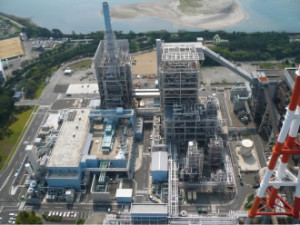東京電力が福島県広野町と福島県いわき市勿来で建設を計画している二つの大型石炭化複合発電設備実証計画の計画段階環境配慮書に対して、環境大臣は7月3日、意見書を経済産業大臣に提出しました。
しかし、驚くべきことに、意見書では、この大型石炭火発事業の実施により福島県の経済復興や雇用回復・創出に資することへの期待が示されるとともに、温室効果ガスの排出量が多い石炭火力発電設備としては最高水準の効率となることが見込まれるとして、できるだけ早期に実証を終了させ、信頼性が確保された発電技術として確立することへの期待が示されているのです。しかも、広野と勿来の両設備が並行して実証を行なう利点を活かして実証項目の合理化を図ること問うにより実証期間の短縮かを図り、商用プラントとして位置づけられるように促してもいます。
本当でしょうか?
現在の電力システムにおいては、原発と同じ大規模集中型の発電所である石炭火力が、一体どれほどの地元経済の復興に役立ち、地域雇用を生み出すというのでしょうか?むしろ、福島から東京に電気を送るような大規模集中型の電力システムこそ見直さなければならない時に、将来性のない、時代錯誤の電源をまた福島に押しつけ、大きなリスクをもたらそうとしているのではないでしょうか。
意見書では一方で、この二件の「配慮書」が二酸化炭素排出削減の目標との整合が示されていないことを指摘しています。「国の二酸化炭素排出削減の目標・計画と整合性が確保されているもの」と整理して、局長級取りまとめをふまえることが必要だとし、各論の中では「事業者が自主的取組みとして天然ガス火力を超過する分に相当する純増分について海外での削減に係る取組みを行なうなどの環境保全措置を講じること」を事業の運転開始までに満たすことを求めています。さらに、2050年80%削減の長期目標との整合性をはかり、将来のCCSの導入に向けて所用の検討を行なうことなども求めました。
これらは、CO2影響を考えた意見だと言えます。しかし、“世界最高効率”であっても天然ガス火力発電所の2倍以上の温室効果ガスを排出するという石炭火力は、新規に建設して別の削減事業と相殺するレベルのものではなく、そもそも建設を止めて、再生可能エネルギーや、過渡的手段としては高効率天然ガス火力の方に投資を振り向けるべきでしょう。
環境省には、石炭火力がもたらすCO2影響を見極めて、もっと厳しい意見を求めたいところです。
<参考>
福島復興大型石炭ガス化複合発電設備実証計画(広野)に係る計画段階環境配慮書に対する環境大臣意見の提出について(お知らせ)
http://www.env.go.jp/press/press.php?serial=18364
福島復興大型石炭ガス化複合発電設備実証計画(勿来)に係る計画段階環境配慮書に対する環境大臣意見の提出について(お知らせ)
http://www.env.go.jp/press/press.php?serial=18365
茨城県に計画中の石炭火力発電もCO2の検討せず~これで本当に“環境配慮”書?~
https://sekitan.jp/info/kashima_ikensho/
On July 3rd, the Minister of Environment commented on the planning phase environmental impact statement for TEPCO’s demonstration plans for two large-scale with integrated coal gasification combined cycle (IGCC) plants set to be built in Hirono and Nakoso, Fukushima prefecture.
Yet, surprisingly, these comments express the ministry of environment’s expectation that these large scale coal-fired power projects will revive Fukushima’s economy by improving the employment situation etc. In addition, given that these plants are expected to have the highest level of efficiency for IGCC technology, from these comments we can see that the Minister anticipates that the demonstration will be completed as soon as possible and reliable electric generation equipment will be established. Moreover, by having the demonstration of both Hirono and Nakoso taking place simultaneously, Minister is urging that the demonstration period be shortened and is pushing for the establishment of the facilities as commercial plants.
In today’s electrical power system, how much would a coal-fired power plant, a large scale concentrated power plant similar to a nuclear power plant, contribute to the regional economy? Rather, aren’t these plants bringing about a bigger risk by imposing an old-fashioned electricity system on Fukushima? Now is the time to reconsider these large-scale power systems.
The Minister pointed out that in the two environmental impact statements, however, there is no mention of any measures consistent with the goal to reduce carbon dioxide emissions. The minister’s comments include a request to the electric power industry to consider MoE and METI’s agreement, which requests utilities to take measures in order to guarantee that the industry is consistent with national climate targets and to establish a voluntary framework to reduce net increases in emissions overseas emission reductions etc (in regards to keeping additional emission levels on par with emissions from natural gas). To be consistent with the national long-term goal to reduce emissions by 80% by 2050, the Minister also urges utilities to consider projects that adopt CCS technology.
We can tell from these comments that the Minister is considering the effects of CO2 emissions. However, even the “world’s most efficient” coal-fired power plant release greenhouse gases two times that of a natural gas-fired power plant. Furthermore, the impacts of large amounts of CO2 emissions are considerable even when other offset measures to reduce emissions are considered.. As a preventative measure, it is better to stop building new coal-fired power plants, and to invest towards renewable energy or build highly efficient natural gas-fired power plants as a transitional measure.
It is imperative that the Ministry of Environment examine the effects of CO2 emissions released by coal-fired power plants more seriously and give constructive criticism to utilities on their power plant projects.
Sources:
Comments by the Minister of Environment toward the planning phase environmental impact statement for the large scale integrated coal gasification combined cycle equipment demonstration plans(Hirono) for Fukushima’s revitalization (Press Release)
http://www.env.go.jp/press/press.php?serial=18364
Comments by the Minister of Environment toward the planning phase environmental impact statement for the large scale integrated coal gasification combined cycle equipment demonstration plans (Nakoso) for Fukushima’s revitalization (Press Release)
http://www.env.go.jp/press/press.php?serial=18365
CO2 not considered in “environmental” impact statement for planned coal power plant in Ibaraki
https://sekitan.jp/en/info/kashima_ikensho/


